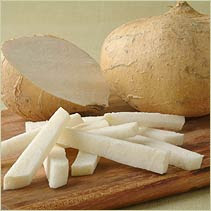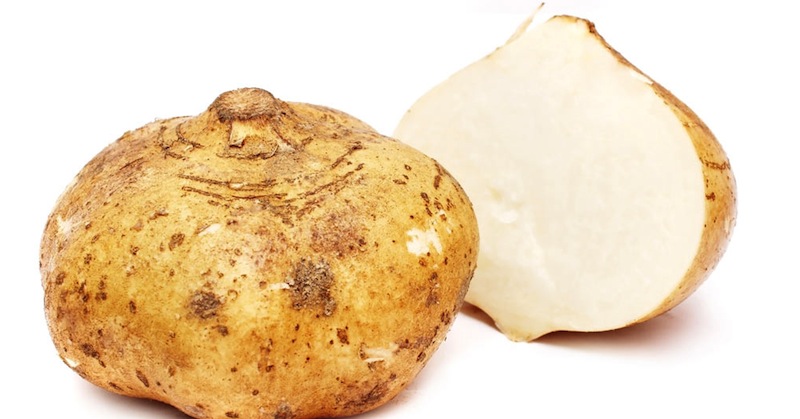Health Benefits of Jicama
Last updated on
Jicama is a large and bulbous root vegetable. Its skin is thick and brown in color, with very juicy white crunchy flesh. It can be consumed either raw or cooked (but best eaten raw for its optimum health benefits).
Jicama is pronounced as hee-ka-ma. It is also known by names like yam bean, Mexican water chestnut, Mexican potato, Mexican turnip, yacon and sengkuang.
The skin of jicama is thick but it’s easy to peel. Wash it under running water to clean off the excess soil, before peeling off its skin.
Nutritional Benefits Of Jicama
Jicama is rich with vitamins A, C, K and the B vitamins. There is a good balance of sodium and potassium present in jicama, making it useful for alkalizing the blood. Minerals in this vegetable are calcium, iron, magnesium, manganese and zinc.
Health Benefits Of Jicama
Health benefits of jicama are many. It is an ideal food for health whether eaten raw or cooked. It is low in calories, cholesterol and fats, and has excellent anti-oxidant and an anti-inflammatory properties.
Breathlessness and asthma: Jicama contains high anti-oxidant and anti-inflammatory properties that are helpful for relieving breathlessness and asthma.
Bruising and swelling: Deficiency of vitamin C can cause bruising and swelling problems for some people. So eating jicama helps reduce deficiency problems that result in easy bruising and swelling.
Cold and flu: Including jicama in your daily juice fix helps prevent cold and flu.
Immune system: Include jicama as your regular juice ingredient to benefit from its overall medicinal properties that provide support to strengthen the immune system. A strong immune system prevents many health problems.
Nose bleeding: Nose bleeding is caused by weak capillaries. The high vitamin C content in jicama supports and help strengthen capillary damages, thus reducing the risks of nose bleeding.
Skin health: Regular consumption of jicama help improve skin tone and helps wounds heal faster, giving the skin a healthier appearance.
Weight loss snack: As an extremely low calorie food, jicama can be chosen as a weight loss snack item, thus helping you reduce the intake of calories in the body.
Consumption Tips

Store jicama in a cool and dry place. Keep sliced jicama in a plastic bag in an airtight container and consume within two days to get the most out of it.
Jicama juice tastes very mild and sweet; and it mixes well with most green juices and juices of other root vegetables, like lotusroot, carrot, beetroot. This is one of my favorite juice recipe using jicama which is very alkalizing and a great immune booster.
Some of the links I post on this site are affiliate links. If you go through them to make a purchase, I will earn a small commission (at no additional cost to you). However, note that I’m recommending these products because of their quality and that I have good experience using them, not because of the commission to be made.
Comments
Leave a Reply

































 JOIN OVER
JOIN OVER
In Philippines we call the jicama – singkamas. I like this root vegetable, not sweet no sugar good to eat for diabetic patient … like yakun
Only the jicama roots are edible. The other parts of the jicama plant that is – leaves, vines, and flowers are proven to contain rotenone, which is highly toxic.
great info! TY